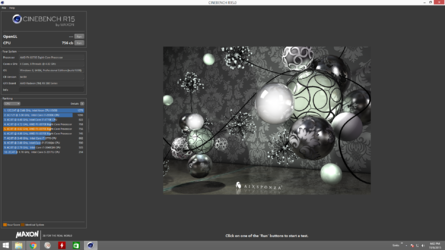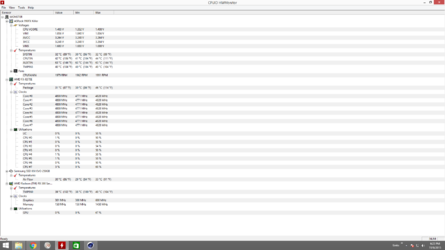There is still plenty of variance on each and every CPU, regardless of binning. Its also easier to bin down than it is to bin up. When you bin up, there are hard limits (TDP/Voltage for example), but when you bin down, you are trying to fit the CPU into an artificial 'bin'. An 8370E could be a regular 8370.
-
Welcome to Overclockers Forums! Join us to reply in threads, receive reduced ads, and to customize your site experience!
You are using an out of date browser. It may not display this or other websites correctly.
You should upgrade or use an alternative browser.
You should upgrade or use an alternative browser.
AMD FX 8370E Noob build and overclock to 4.8ghz
- Thread starter Cwwc-Stalker
- Start date
- Joined
- Jan 1, 2008
- Location
- Colorado Springs, CO
There is still plenty of variance on each and every CPU, regardless of binning. Its also easier to bin down than it is to bin up. When you bin up, there are hard limits (TDP/Voltage for example), but when you bin down, you are trying to fit the CPU into an artificial 'bin'. An 8370E could be a regular 8370.
Or is could be a 9xxx as well
That is what we all hope for when buying a lower binned chip
That is a hope... though typically there are reasons why a chip is binned lower (it can't make the higher bins). But there are at least a few variables that can affect things too (such as supply and demand). So if these 'E' chips are low on supply because yields are good and they are making a lot of the higher bins and no 'natural' lower bins, they just set some lower that could reach the higher bin.
It is rare to see a lower bin not reach a higher bin. What we DON'T see there (or care about in our case) is that it breaches the TDP for the part. BUT... those could be good for extreme (read: sub ambient) overclocking because they may be leaky.
It is rare to see a lower bin not reach a higher bin. What we DON'T see there (or care about in our case) is that it breaches the TDP for the part. BUT... those could be good for extreme (read: sub ambient) overclocking because they may be leaky.
- Joined
- Dec 19, 2012
Or is could be a 9xxx as well
That is what we all hope for when buying a lower binned chip
Trust me if you've ever read up on them it's not what you hope for by accident. You WON'T be prepared for it. These 9xxx are super hot, and draw a ton of power even compared to similar clocked 8xxx series chips. Many have a VID of 1.55v for 4.7 with 5 turbo
Even people with full loops have a hard time taming them when setting manual V-Core.
- Joined
- Aug 16, 2009
That poses an interesting question though, how the hell is the OP managing 4.8ghz at 1.425v ? (sorry just clicked)
That's just a matter of what he is using to test stability. If that is prime95 he won the lottery though if that is just AIDA well there are not many users here that would consider that stable, I know I wouldn't but then it is not my chip. I am sure there are users here that would not consider just 2 hours of prime as stable either but hey just keep that to themselves mostly.
- Joined
- Sep 15, 2015
- Location
- Pensacola, Fl
IMO if you're failing p95, you're not stable. I don't have experience with your chip, but I need 1.45v(1.48 loaded) to hit 4.8ghz and pass 2 hours of blend with my 8350. If one core consistently failed you're close to required voltage, if one core or the other in a module fails you may have reached a "limit" where more voltage won't help stability, if cores randomly fail across all modules you're nowhere near the voltage required for stability. Also, I'd put the stock AMD fan on the vrm heatsink. Put the corsair 120 on the backplate and plug in into a fan header that that allows you to switch it on and off, I'd bet you'll notice the stock CPU fan is doing the bulk of the cooling as its cooling a much more localized spot. And lastly your socket and core temps are a little higher than I'd be comfortable with, especially if you're not using p95 to test for stability. 72c@socket, 62c@core.
OP
- Joined
- Nov 5, 2015
- Thread Starter
- #28
Sorry guys but if you really are interested in figuring out a solution please read my first post... I did attemp to put a fan on the backplate even resorted to putting a high powered house fan right up to the motherboard to no effect.
As to P95, I have came across now many AMD users who have the same problem. I pass every stress except p95 so yeah I think it's stable.And yes I know about binning but the 8370e seems to oc better and lower v then all the other new fx chips for home use, not talking about world records here.
P95 isn't the end all be all, I respect your opinion I do and with that being said I consider 4.8 at 1.4250 stable. Most still think the fx 6's 62c core limit holds for the fx 8's and 9's but it's not true. AMD's own threshold proves 72c on the cores itself is the max recommended temp. and who's to say the whole problem here isn't the sensor on the board being retarded. Apparently at high temps and loads they are very inaccurate.
Thanks for all of your inputs though whether I agree or disagree I think this is very helpful.
Also....... I can tell you right now when I was using a Tt 600watt power supply I failed every test and now that I upgraded to an evga 1000watt gold it was the biggest difference in stablility for me, so to all those needing higher volts upgrade to a better pwoer supply and/or use LLC or put in an offset number like my asrock has to do. If you let your volts run wild you will need a higher voltage!
As to P95, I have came across now many AMD users who have the same problem. I pass every stress except p95 so yeah I think it's stable.And yes I know about binning but the 8370e seems to oc better and lower v then all the other new fx chips for home use, not talking about world records here.
IMO if you're failing p95, you're not stable. I don't have experience with your chip, but I need 1.45v(1.48 loaded) to hit 4.8ghz and pass 2 hours of blend with my 8350. If one core consistently failed you're close to required voltage, if one core or the other in a module fails you may have reached a "limit" where more voltage won't help stability, if cores randomly fail across all modules you're nowhere near the voltage required for stability. Also, I'd put the stock AMD fan on the vrm heatsink. Put the corsair 120 on the backplate and plug in into a fan header that that allows you to switch it on and off, I'd bet you'll notice the stock CPU fan is doing the bulk of the cooling as its cooling a much more localized spot. And lastly your socket and core temps are a little higher than I'd be comfortable with, especially if you're not using p95 to test for stability. 72c@socket, 62c@core.
P95 isn't the end all be all, I respect your opinion I do and with that being said I consider 4.8 at 1.4250 stable. Most still think the fx 6's 62c core limit holds for the fx 8's and 9's but it's not true. AMD's own threshold proves 72c on the cores itself is the max recommended temp. and who's to say the whole problem here isn't the sensor on the board being retarded. Apparently at high temps and loads they are very inaccurate.
Thanks for all of your inputs though whether I agree or disagree I think this is very helpful.
Also....... I can tell you right now when I was using a Tt 600watt power supply I failed every test and now that I upgraded to an evga 1000watt gold it was the biggest difference in stablility for me, so to all those needing higher volts upgrade to a better pwoer supply and/or use LLC or put in an offset number like my asrock has to do. If you let your volts run wild you will need a higher voltage!
Last edited:
OP
- Joined
- Nov 5, 2015
- Thread Starter
- #30
Run Cinebench R15. If it finishes, you're stable enough for most anything.

There you go... Beats out many i7's even comparable fx's so I think I'm doing well
At the number 6 spot, that was with my old power supply so if you ever wanted to know if they make a difference, the answer is yes
Last edited:
OP
- Joined
- Nov 5, 2015
- Thread Starter
- #32
ThanksNice. Your temps are high IMO, but if it works for you......

These are idle temps although I know you cannot go by these I am just curious if the socket temp sensor is being a dumb ***.
FYI some still are confused about this but package temp is the CORE temp, cputin is the socket temp.
I do not disagree.Thanksbut lets be real, I never hit above 55 on the core or socket while gaming, or anything else, just in stress tests so realistically they SHOULD be fine.
- Joined
- Jan 1, 2008
- Location
- Colorado Springs, CO
And also the only warnings I get with p95 is illegal sumouts from which I read is memory related, but I could be wrong.
Try bumping your cpu-nb voltage one notch
- Joined
- Jan 1, 2008
- Location
- Colorado Springs, CO
1.4 seems quite high for the cpu-nb voltage.... I'd wait for one of the more experienced guys to chime in, but I know the FX series have some issues with high ram clocks and large ram capacities...
OP
- Joined
- Nov 5, 2015
- Thread Starter
- #38
I never even thought about that, good point. at the end of the day, long as I keep this thing alive until Zen I'll be happy. if I fry it the day after zen, no tears will be shed.1.4 seems quite high for the cpu-nb voltage.... I'd wait for one of the more experienced guys to chime in, but I know the FX series have some issues with high ram clocks and large ram capacities...
- Joined
- Jan 1, 2008
- Location
- Colorado Springs, CO
I never even thought about that, good point. at the end of the day, long as I keep this thing alive until Zen I'll be happy. if I fry it the day after zen, no tears will be shed.
Honestly, if your cpu-nb freq is stock, and your voltage normally isn't that high. Unless I am off my rocker completely, I seem to recall cpu-nb voltage being like 1.2-1.25 stock
- Joined
- Jan 1, 2008
- Location
- Colorado Springs, CO
Yeah http://www.overclockers.com/forums/showthread.php?t=688663 says 1.35v is the max safe on air (granted this is all relative) and others have exceeded that by a fairly significant amount, but 1.4v is quite high for cpu-nb voltage. Are you overclocking your cpu-nb freq as well or just the CPU?